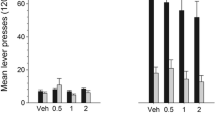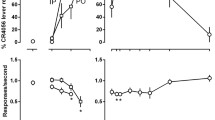Abstract
The present study was designed to assess the behavioral similarity of the effects of prototype dopamine receptor-subtype selective agonists and cocaine. Squirrel monkeys (N=4) were trained with food reinforcement to press one of two levers after administration of IV cocaine (0.3 mg/kg) or the other lever after saline. After training, IV cocaine produced reliable responding on the cocaine lever (>98%), whereas saline produced reliable responding on the alternate lever (>98%). The D2 agonist, quinpirole (0.003–1.0 mg/kg, IM), produced dose-related increases in cocaine-appropriate responding, with maximal effects of 62%. When delivered IV, quinpirole (0.01–0.17 mg/kg) was approximately twice as potent, but no more effective. The D1 agonist, SKF 38393 (0.3–30.0 mg/kg, IM or 3.0–17.0 mg/kg, IV) failed to produce any significant cocaine-appropriate responding. Further, pretreatment with SKF 38393 (either 0.3 or 10.0 mg/kg, IM) did not significantly alter the the quinpirole (0.01–1.0 mg/kg, IM) dose-effect curve. The effects of these drugs differ from those previously reported in rats, suggesting a species difference that may be of importance in evaluating the behavioral pharmacology of cocaine.
Similar content being viewed by others
References
Arnt J, Bogesso KP, Hyttel J, Meier E (1988) Relative dopamine D1 and D2 receptor affinity and efficacy determine whether dopamine agonists induce hyperactivity or oral stereotypy in rats. Pharmacol Toxicol 62:121–130
Barrett JE (1985) Behavioral pharmacology of the squirrel monkey. In: Rosenblum LA, Coe CL (eds) Handbook of squirrel monkey research. Plenum Press, New York, pp 315–348
Barrett RL, Appel JB (1989) Effects of stimulation and blockade of dopamine receptor subtypes on the discriminative stimulus properties of cocaine. Psychopharmacology 99:13–16
Callahan PM, Appel JB, Cunningham KA (1991) Dopamine D1 and D2 mediation of the discriminative stimulus properties ofd-amphetamine and cocaine. Psychopharmacology 103:50–55
Clark D, White FJ (1987) Review: D1 dopamine receptor-the search for a function: a critical evaluation of the D1/D2 dopamine receptor classification and its functional implications. Synapse 1:347–388
Finney DJ (1964) Statistical methods in biological assay, 2nd edn. Hafner, New York
Hake DF, Azrin NH (1963) An apparatus for delivering pain shock to monkeys. J Exp Anal Behav 6:297–298
Herd JA, Morse WH, Kelleher RT, Jones LG (1969) Arterial hypertension in the squirrel monkey during behavioral experiments. Am J Physiol 217:24–29
Katz JL, Sharpe L, Jaffe JH, Shores EI, Witkin, JM (1991) Discriminative stimulus effects of inhaled cocaine in squirrel monkeys. Psychopharmacology 105:317–321
Kelleher RT, Gill CA, Riddle WC, Cook L (1963) On the use of the squirrel monkey in behavioral and pharmacological experiments. J Exp Anal Behav 6:249–252
Kleven MS, Anthony EW, Woolverton WL (1990) Pharmacological characterization of the discriminative stimulus effects of cocaine in rhesus monkeys. J Pharmacol Exp Ther 254:312–317
Kleven MS, Anthony EW, Goldberg LI, Woolverton WL (1988) Blockade of the discriminative stimulus effects of cocaine in rhesus monkeys with the D1 dopamine antagonist SCH 23390. Psychopharmacology 95:427–429
Snedecor GW, Cochran WG (1967) Statistical methods, 6th edn. Iowa State University Press, Ames, Iowa, pp 135–171
Witkin JM, Nichols DE, Terry P, Katz JL (1991) Behavioral effects of selective dopaminergic compounds in rats discriminating cocaine injections. J Pharmacol Exp Ther 257:706–713
Woolverton WL, Kleven MS (1988) Multiple dopamine receptors and the behavioral effects of cocaine. NIDA Res Monogr 88:160–183
Woolverton WL, Goldberg LI, Ginos JZ (1984) Intravenous self-administration of dopamine receptor agonists by rhesus monkeys. J Pharmacol Exp Ther 230:678–683
Author information
Authors and Affiliations
Rights and permissions
About this article
Cite this article
Katz, J.L., Witkin, J.M. Effects of quinpirole and SKF 38393 alone and in combination in squirrel monkeys trained to discriminate cocaine. Psychopharmacology 107, 217–220 (1992). https://doi.org/10.1007/BF02245140
Received:
Revised:
Issue Date:
DOI: https://doi.org/10.1007/BF02245140




